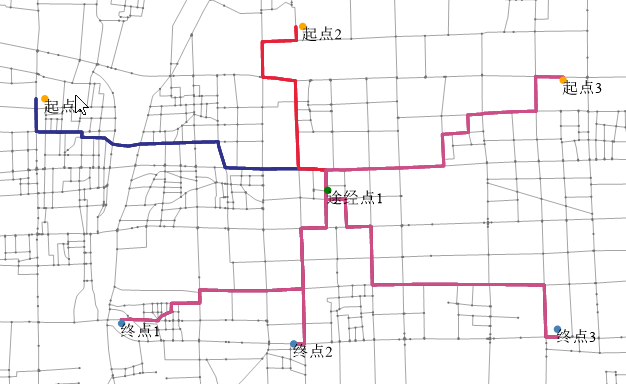Feature Description
Multi-point optimal path analysis extends optimal path analysis by supporting multiple start and end points. Each start point will sequentially pass through specified routing points to reach all end points.
Application Scenarios
In the multiple traveling salesman problem (MTSP) analysis industry, the process from seller shipment to buyer delivery involves multiple logistics transfer stations. A transfer station collects goods from multiple sellers and dispatches them to the next station based on addresses until final delivery. This complex process requires multiple start-end inputs in traditional optimal path analysis. With multi-point optimal path analysis, logistics managers can input all start points (seller addresses), transfer stations and end points (buyer addresses) at once to obtain optimal delivery routes for all logistics.
Steps
 Caution:
Caution: The application processes multi-point optimal path analysis according to the sequence of sites in the Network Analysis Instance Manager window.
- Before performing multi-point optimal path analysis, configure the network analysis environment. For details, see Network Analysis Environment Settings window.
- In the Transport Analysis Tab -> Route Analysis group, click the Gallery drop-down button and select Multi-point Optimal Path Analysis to create an analysis instance. For interface details, see Instance Manager window.
- In the current window, click to add sites and barrier points by mouse. For specific operations, refer to Add Site and Barrier Management.
- Click the "Parameter Settings" button in the Instance Manager window to configure analysis results:
- Save node information: Choose whether to save all node information along the analysis path. When checked, node information will be saved as a point dataset in the network dataset's datasource. This dataset records NodeID and corresponding RouteID.
- Save edge information: Choose whether to save all edge information along the analysis path. When checked, edge information will be stored as a line dataset in the network dataset's datasource. This dataset records EdgeID of the result route.
- After completing all parameter settings, click the Execute button in the Instance Manager window to perform the analysis.
Upon completion, analysis results will automatically display on the current map. The output window will show: "Multi-point optimal path analysis executed successfully."
The multi-point optimal path analysis results appear as follows: Each start point corresponds to a unique color, with overlapping sections displaying the color of the last analysis result.




